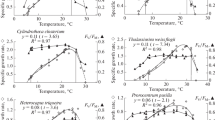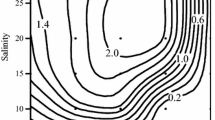Abstract
The marine plankton diatom Thalassiosira rotula Meunier was isolated from the North Sea and cultivated in enriched sea water. The influence of temperature and light was investigated with regard to generation time, sinking rate and colony size (cells per chain). Petri dishes containing 10 ml culture medium were used as culture vessels for experimental work. Cell concentrations during experiments are comparable to natural concentrations of many North Sea plankton diatoms. Generation time was investigated using 11 different combinations of temperature and light. The doubling time varies between 9 h (2400 lux, 22°C; 5500 lux, 12°C) and 40 h (2400 lux, 4°C; 600 lux, 12°C). Two different isolates from Ostend and Helgoland, cultivated at different seasons (spring and autumn), exhibit the same generation time (15.5 h; 2400 lux, 12°C). Furthermore, doubling time does not change over a period of 70 generations. Colony size may be influenced by temperature and light intensity. High temperature (22°C) combined with light intensity. High temperature (22°C) combined with light saturation causes very short cells chains, low light intensity (1200 lux) unusually long cell chains. The specific gravity of T. rotula is proportional to light intensity. With increasing light intensity the sinking rate also increases. T. rotula prefers low light intensities, with an optimal range presumably between 1000 and 3000 lux. Generation times effecting a large cell density are limited by special constellations of temperature and light, which are rarely found in the sea. Optimum growth rates in the sea should be possible near 14°C and 2000 to 3000 lux.
Zusammenfassung
-
1.
Die marine Kieselalge Thalassiosira rotula Meunier wurde in teilsynthetischem Nordseewasser kultiviert und bei Zelldichten untersucht, die den natürlichen Planktonkonzentrationen in der Nordsee entsprechen.
-
2.
Die Generationszeit von T. rotula wurde bei 11 verschiedenen Licht-Temperatur-Konstellationen ermittelt. Kurze Verdoppelungszeiten um 9 Std waren bei mittleren Beleuchtungsstärken (2400 Lux) an hohe Temperaturen (22°C) und bei mittleren Temperaturen (12°C) an hohe Beleuchtungsstärken (5500 Lux) geknüpft. Die längste Generationszeit betrug etwa 40 Std, bedingt durch niedere Temperaturen (4°C) oder geringe Beleuchtungsstärken (600 Lux).
-
3.
Bei Ostende und Helgoland isolierte und zu verschiedenen Jahreszeiten (Frühjahr und Herbst) kultivierte Stämme von T. rotula wiesen die gleiche Generationszeit auf (15,5 Std bei 2400 Lux und 12°C). Außerdem blieb die Verdoppelungszeit über eine Folge von mindestens 70 Generationen hin unverändert.
-
4.
Die Kettenlänge (Zellzahl pro Kette) von T. rotula kann durch Temperatur und Beleuchtungsstärke beeinflußt werden. Eine hohe Temperatur von 22°C hatte bei Lichtsättigung sehr kurze Zellketten zur Folge. Die geringe Beleuchtungsstärke von 1200 Lux verursachte bei mittleren Temperaturen die Bildung ungewöhnlich langer Zellketten.
-
5.
Spezifisches Gewicht von T. rotula und Beleuchtungsstärke verhielten sich proportional zueinander. Mit zunehmender Beleuchtungsstärke vergrößerte sich die Sinkgeschwindigkeit der Kieselalge.
-
6.
T. rotula erweist sich als Schwachlichtalge. Die optimalen Beleuchtungsstärken für die Zellteilung liegen zwischen 1000 und 3000 Lux. Die Art erreicht nur bei sehr begrenzten Licht-Temperatur-Konstellationen Generationszeiten, die eine größere Beteiligung am Phytoplanktonbestand im Meere ermöglichen. Günstigste Entwicklungsbedingungen werden bei etwa 14°C und 2000 bis 3000 Lux erwartet.
Similar content being viewed by others
Zitierte Literatur
Allen, E. J.: On the culture of the plankton diatom Thalassiosira gravida Cleve, in artificial sea-water. J. mar. biol. Ass. U.K. 10, 417–439 (1914).
Bentley, J. A.: Role of plant hormones in algal metabolism and ecology. Nature, Lond. 181, 1499–1501 (1958).
Braarud, T., K. R. Gaarder and J. Grøntved: The phytoplankton of the North Sea and adjacent waters in May 1948. Rapp. P.-v. Réun. Cons. perm. int. Explor. Mer 133, 1–89 (1953).
Cupp, E. E.: Marine plankton diatoms of the West Coast of North America. Bull. Scripps Instn Oceanogr. (tech. Ser.) 5, 1–237 (1943).
Gran, H. H.: Pelagic plant life. In: Depths of the ocean, Chapter 6. pp 307–386. Ed. by Murray and Hjort. London: MacMillan 1912.
— and E. C. Angst: Plankton diatoms of Puget Sound. Publs Puget Sound mar. biol. Stn 7, 417–519 (1931).
Hellebust, J. A.: Light. Plants. In: Marine ecology, Vol. I. Environmental factors, Pt1, pp 125–158. Ed. by O. Kinne. London, New York, Sydney, Toronto: Wiley-Interscience 1970.
Hustedt, F.: Die Kieselalgen Deutschlands, Österreichs und der Schweiz unter Berücksichtigung der übrigen Länder Europas sowie der angrenzenden Meeresgebiete, 1. Teil. 920 pp. Leipzig: Akademische Verlagsgesellschaft 1930.
Jeferey, S. W. and M. B. Allen: Pigments, growth and photosynthesis in cultures of two chrysomonads, Coccolithus huxleyi and a Hymenomonas sp. J. gen. Microbiol. 36, 277–288 (1964).
Jitts, H. R., C. D. Mcallister, K. Stephens and J. D. H. Strickland: The cell division rates of some marine phytoplankters as a function of light and temperature. J. Fish. Res. Bd Can. 21, 139–157 (1964).
Meunier, A.: Microplancton des mers de Barents et de Kara. Due d'Orléans, Campagne Arctique de 1907, 355 pp. Bruxelles: Charles Bulens 1910.
Schöne, H.: Untersuchungen zur ökologischen Bedeutung des Seegangs für das Plankton mit besonderer Berücksichtigung mariner Kieselalgen. Int. Revue ges. Hydrobiol. 55, 595–677 (1970).
Smayda, Th. J. and B. J. Boleyn: Experimental observations on the flotation of marine diatoms. I. Thalassiosira cf. nana, Thalassiosira rotula and Nitzschia seriata. Limnol. Oceanogr. 10, 499–509 (1965).
—— and B. J. Boleyn: Experimental observations on the flotation of marine diatoms. II. Skeletonema costatum and Rhizosolenia setigera. Limnol. Oceanogr. 11, 18–34 (1966).
Stosch, H. A. Von und G. Drebes: Entwicklungsgeschichtliche Untersuchungen an zentrischen Diatomeen. IV. Die Planktondiatomee Stephanopyxis turris, ihre Behandlung und Entwicklungsgeschichte. Helgoländer wiss. Meeresunters. 11, 209–257 (1964).
Trégouboff, G. et M. Rose: Manuel de planctonologie méditerranéenne, tome I. 587 pp. Paris: Centre National de la Recherche scientifique 1957.
Author information
Authors and Affiliations
Additional information
Communicated by O. Kinne, Hamburg
Rights and permissions
About this article
Cite this article
Schöne, H.K. Experimentelle Untersuchungen zur Ökologie der marinen Kieselalge Thalassiosira rotula. I. Temperatur und Licht. Marine Biology 13, 284–291 (1972). https://doi.org/10.1007/BF00348075
Accepted:
Issue Date:
DOI: https://doi.org/10.1007/BF00348075




